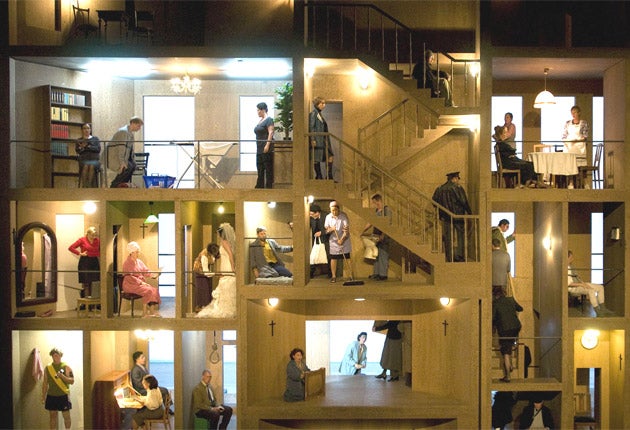Actus Tragicus/ Experimentum Mundi, Festival Theatre/ Traverse Theatre, Edinburgh
Flat lives and bright sparks

If you've ever wondered about the humdrum existences of people cooped up in a block of tiny flats, the late Herbert Wernicke's artistic vision of life and death played out in a couple of dozen tiny spaces should satisfy your curiosity. Relentlessly mundane in many ways – not least in the endless repetition of gestures and sequences of tiny scenarios – the music-theatre piece Actus Tragicus is fascinating, up to a point.
On a gigantic wooden set without an outer wall, fifty members of the Stuttgart Opera Chorus are revealed going about their business, in silence for the first few minutes. A transvestite irons a shirt, a reluctant bride struggles from her wedding dress, a couple makes fragmentary love, a man contemplates hanging himself, a family have supper, a postman flits from flat to flat and a cleaner brushes the stairwell. Elsewhere, a tramp begs from a blind man, a gym freak works out, a mother cradles a child and, while a pajama-clad figure seems on the verge of giving up the ghost, a black coffin is carried on and off. These are just some of the activities which, acted out over and over again, accompany a sequence of six sacred cantatas by J S Bach, including his famous funeral cantata nicknamed "Actus Tragicus".
A white-masked and gloved grim reaper stalks the unfortunate residents of this building, at the foot of which lies a figure of Christ, from a painting by Holbein in the Basel museum where this production originated. If the staged action, representing approaching death, became less engrossing as the evening wore on, the music never really took off. Stringing the cantatas together in a sequence blurs their musical character and the text's individuality.
Few of the soloists shone, while under Michael Hofstetter the orchestra plodded on, some eloquent woodwind apart. In the end it was a deadly experience, though scarcely in the way Wernicke intended, I suspect.
Conducting his own Experimentum Mundi, Giorgio Battistelli also combined music and visual imagery with repetition but in a far more scintillating way. He was joined on stage by an orchestra of Italian artisans – knife-grinders, brickies, stone-cutters, carpenters, cobblers and coopers as well as an inscrutable pastry cook who scrunched eggshells, dramatised dough and looked every inch a kitchen prima donna. To the rhythmically intricate clinking and crashing of their tradesmen's tools, Hilton McRae added readings from Diderot's Encyclopédie, four intrepid women whispered, yowled and yelled and Nicola Raffone darted sure-fingeredly around a barrage of percussion. Sparks flew and you could almost believe you were in the busy little village of Albano Laziale, where the next remarkable generation of artisans continues the family tradition, as well as re-enacting it in Battistelli's wonderfully evocative symphonic cacophony.
Subscribe to Independent Premium to bookmark this article
Want to bookmark your favourite articles and stories to read or reference later? Start your Independent Premium subscription today.

Join our commenting forum
Join thought-provoking conversations, follow other Independent readers and see their replies